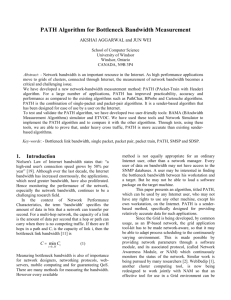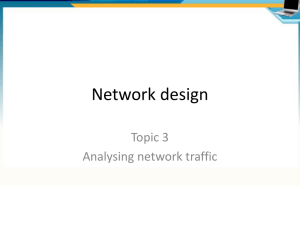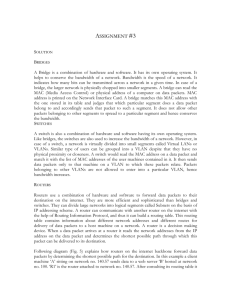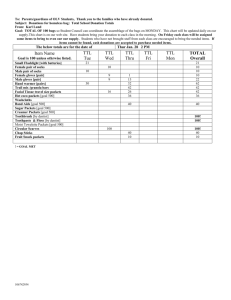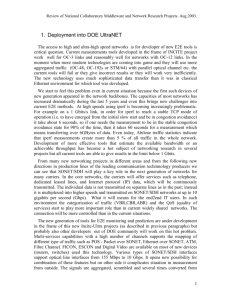UoWSCS Technical Repor t# 04-004
advertisement
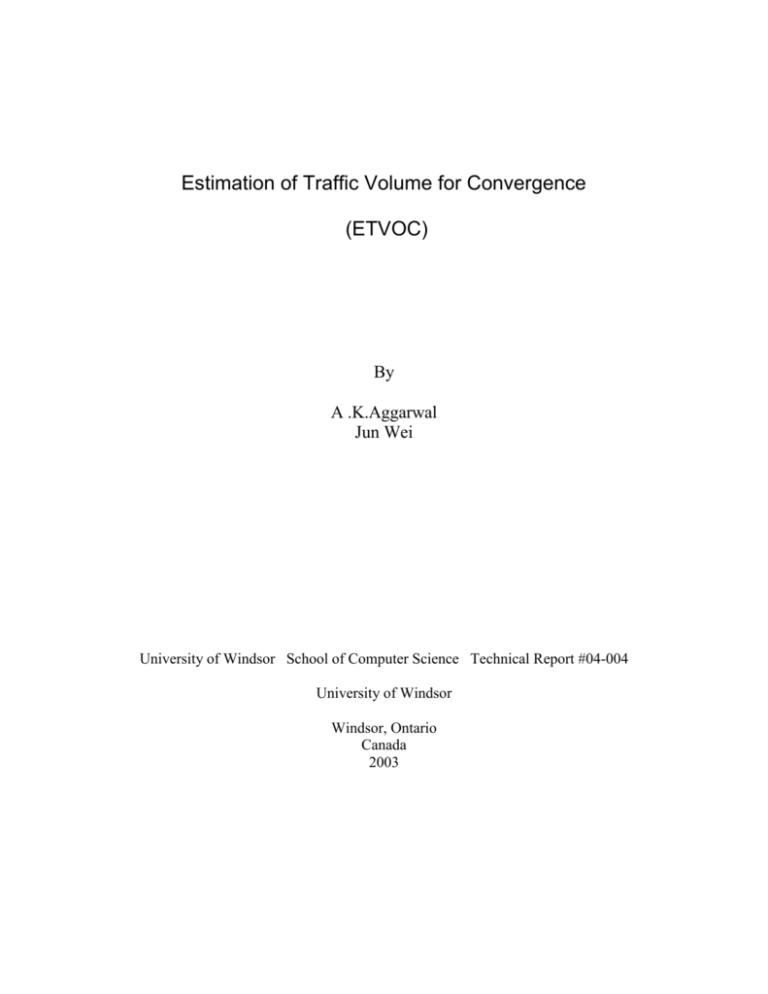
Estimation of Traffic Volume for Convergence (ETVOC) By A .K.Aggarwal Jun Wei University of Windsor School of Computer Science Technical Report #04-004 University of Windsor Windsor, Ontario Canada 2003 Abstract To improve the practicability, accuracy and performance of existing network-bandwidth measurement algorithms, such as PathChar, Bprobe and Cartouche algorithm, we have developed a new method: PATH (PAcket-Train with Header) algorithm. PATH is the combination of single-packet and packet-pair algorithms. It uses SMSP to find out the position of the bottleneck link. We developed a tool called ETVOC to compare the SMSP and SDSP algorithm. Our experiments show that the SMSP algorithm sends much less data traffic volume than the SDSP algorithm. Keywords: Bottleneck link bandwidth, single packet, packet pair, packet train, PATH, SDSC, SMSP, and SDSP Abstract ............................................................................................................................... 2 1. Introduction ................................................................................................................. 4 2. What is ETVOC .......................................................................................................... 4 3. Development of ETVOC ............................................................................................ 6 4. Tests using ETVOC .................................................................................................... 7 5. Conclusions ................................................................................................................. 9 References ......................................................................................................................... 10 1. Introduction The simple single-packet algorithm (SMSP) can check the network structure and find the position of the bottleneck link. The standard single-packet algorithm (SDSP) measures the bandwidth and latency of each link on the network. PATH algorithm [Jun Wei – Thesis, September 2003] uses SMSP to check the bottleneck position. The tool ETVOC is used to verify the claim that SMSP sends much less traffic than SDSP. 2. What is ETVOC To compare the difference of traffic volume that SDSP and SMSP generate, based on the SDSC dataset [Jac97, Dow99a], we developed a tool for Estimation of Traffic VOlume for Convergence (ETVOC) to analyze the traffic. The SDSC dataset was used by Allen B. Downey for testing pathchar. The dataset refers to the path from the server rocky.colby.edu (on the campus of the Colby College in Waterville, Maine) to mach5.sdsc.edu (at the San Diego Supercomputer Center). There are 14 links in this path. Using the SDSC dataset, for testing pathchar, Downey sent out more than 2880 probes of 45 different sizes (from 120 bytes to 1528 bytes) for each link. Hence the test involved more than 43,000 measurements. To compare the SDSP and SMSP algorithms, using ETVOC, we first send a small number of packets and check the measurements. Based on these measurements, we estimate the position of the bottleneck link (for SMSP) and the bandwidth of each link (for SDSP). If the estimates are not convergent [Dow99a], we go on sending more packets to get additional measurements. The tool will stop only when either the results are convergent or we reach the maximum probes limit. To detect convergence, we divided the sample into two parts, odd and even. By using these two sub-samples, we can get three estimates: one from the odd sub-sample, one from the even part, and one from the whole sample. If the difference between the largest and smallest of these three estimates is less than 10% of the smallest, we assume that the result is convergent. 3. Development of ETVOC We used Java language to develop ETVOC to analyze the SDSC dataset and compare SDSP and SMSP. The flow chart of ETVOC is shown in Figure 3-1: Begin Initialize the bandwidth, latency, and SORTT array Read SDSC dataset into array Divide the sample into two sub-samples (Odd and Even) Calculate the bandwidth and convergence criterion for each link Find the position of bottleneck link Show the result END Figure 3-1 ETVOC Program flow 4. Tests using ETVOC After sending a small number of packets (we call it the first “run”) and checking the measurements, we will send out more packets to get more measurements. There are two ways to send the second run packets: Send packets with same size There are 64 packets for each link in the first run. Their sizes are the same; all are 120 bytes. The size of packets in the following runs will be increased by 32 bytes each time. For example, in the second run, we will send another 64 packets and their size is 152 bytes and so on. By using this method to implement the tool to compare SDSP and SMSP, we found that the SMSP can get an accurate position from the fourth run. For SDSP, most links can get convergent results after 29 runs. The bandwidth measurements for some links are not convergent even after 45 runs. Send packets with different sizes In this case, in the first run, there are 90 packets at 45 different sizes (from 120 bytes to 1528 bytes) for each link. There are two packets for each size. In the second run, we will send another 90 packets at 45 different sizes for each link, and so on. The experiments show that SMSP can get an accurate result from the third run while SDSP cannot get convergent results for some links even after 32 runs. So, from the experiments we discussed above, SMSP consumes many fewer packets than SDSP. The methods based on the standard single-packet algorithm consume a large part of the available network bandwidth and may affect the network performance. The SMSP algorithm reduces the data traffic that PATH generates and improves the efficiency of the PATH algorithm. 5. Conclusions ETVOC is used to validate our new bottleneck link-bandwidth estimation algorithm, PATH, which is a sender-based algorithm and straightforward to implement in the Internet. There are two steps to implement PATH. First, we use SMSP to find out the position of the bottleneck link. Then we send out the PATH probes to measure the bottleneck-link bandwidth. By using ETVOC, our experiments show that the SMSP algorithm sends much less data traffic volume than the SDSP algorithm. References [Dow99a] A. B. Downey, Using pathchar to Estimate Internet Link Characteristics ACM SIGCOMM '99 Pages: 241-250 [Jac97] V. Jacobson, Pathchar - a tool to infer characteristics of Internet paths 97 MSRI talk [Jun Wei - Thesis] Jun Wei, Bottleneck Bandwidth Measurement Using PATH Algorithm (thesis)


